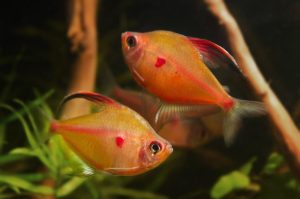Table of Contents
Nitrates in freshwater aquarium
Hence, keeping nitrates at levels safe for fish often relies on maintaining effective biological filtration systems. To effectively reduce nitrate levels in an aquarium, it is crucial to implement proper maintenance techniques.
A variety of biological filter media can be utilized, including sponge filters and ceramic bio-media, as well as incorporating live plants into the ecosystem. Diluting nitrate levels through routine water changes is an additional method for successfully reducing nitrate levels.
To optimize results, it is recommended to replace approximately 10-20% of the aquarium water once a week and consistently monitor nitrate levels using a reliable aquarium test kit. In cases where high nitrate saturation persists despite best efforts, adjusting feeding practices or regularly vacuuming residue off the substrate may become necessary.

What causes high nitrates in a fish tank
In a fish tank environment, elevated nitrates are often observed due to excessive buildup of organic waste materials that originate from various sources such as rotting plants, uneaten food or excretion produced by fishes. The conversion process that leads to this can be traced back to the production of ammonia from fish waste and feed particles through reactions occurring between them and helpful microbial bacteria present within the tank ecosystem. This initial step transforms into a series of stages resulting in the final formation of nitrates.
A situation arises whereby fish produce more organic waste due to overfeeding or overpopulation while the aquarium lacks sufficient beneficial bacteria capable enough to catalyze their conversion adequately. This excess production exceeds these microbes’ ability, leading to unprocessed nitrogenous compounds building up within the ecosystem’s environment as nitrates accumulate along with it. Additionally, depleted populations of such helpful microbes also end up allowing ammonia and nitrite to build up within the substrate.
The presence of high levels of nitrates in an aquarium cannot be attributed to a single factor as several causes are plausible. Inadequate mechanical filtration alongside insufficient water changes and excessive use of chemical filter media can heighten nitrate concentrations.
The issue of elevated nitrate concentrations within an aquarium can pose significant risks for the fish. To maintain a safe environment, it is essential to frequently analyze nitrate levels and implement remedial actions if necessary. Such actions include performing routine water exchanges to dilute accumulated chemicals, improving biological filtration efficiency to break down pollutants or minimizing feedings which are potential sources of excess waste buildup.
Signs of high nitrates in an aquarium
An overabundance of nitrates in a tank environment can prove detrimental to the health and functioning of fish residing within it. Among notable traits indicative of amplified nitrate concentrations are:
1. Algae Growth
Increased nitrate levels cause the proliferation of algae in an aquarium. Manifestations of algae include brown or green films on the substrate, glass, and ornamental objects or stringy white-green algae on plants and decor. Visually unappealing, this situation can also lead to inadequate water quality.
2. Poor Water Clarity
A noticeable turbidity of the water in an aquarium may be attributed to high levels of nitrate. The precipitation is primarily triggered by the increased growth of algae and bacteria, which are supplied with excessive nutrients from the nitrates present.
3. Fish Health Issues
Health issues in fish are likely to arise when they are confronted with excessive amounts of nitrates for extended periods. Reduced immunity and increased stress levels, along with compromised reproductive functions serve as possible consequences. Additionally, affected fish tend to display signs like sluggishness, and reduced appetite.
4. Reduced Oxygen Levels
Reduced levels of oxygen in the aquarium are an issue that arises due to an increase in nitrate content. This particular concern poses a significant threat to various species of fish and other forms of aquatic life whose existence depends heavily on optimal dissolved oxygen concentrations.
5. Stunted Plant Growth
The presence of high nitrate concentrations in the aquarium can result in an unfavourable impact on the development and viability of plants exhibiting symptoms marked by dwarfism, yellowing foliage or mortality.
How to lower nitrates in freshwater aquarium
1. Perform Regular Water Changes
Performing frequent water changes serves as a means to effectively reduce nitrate levels within aquariums. As a result of the removal and replacement of existing tank water with fresh, uncontaminated substitutes during this process, there is a dilution effect on nitrates present within the enclosed environment.
To establish an optimal maintenance routine dependent on factors including population density and overall tank capacity, implementing weekly change equivalent to 10-20% water volumes may serve as an adequate starting point.
2. Increase Biological Filtration
Through the process of biological filtration, ammonia and nitrite are transformed into nitrate by beneficial bacteria in the aquarium filter. A greater surface area for bacterial colonization can be attained through increased biological filtration, leading to reduced nitrate levels. Ceramic bio-media or live plants may provide more room for colonization. Nitrates can be removed from the water column via photosynthesis when live plants are employed.
3. Vacuum the Substrate
The accumulation of uneaten food, fish waste and other organic matter in the substrate of an aquarium can boost nitrate levels. By regular vacuuming during water changes, you can eliminate this debris before it starts to decompose and cause further issues.



